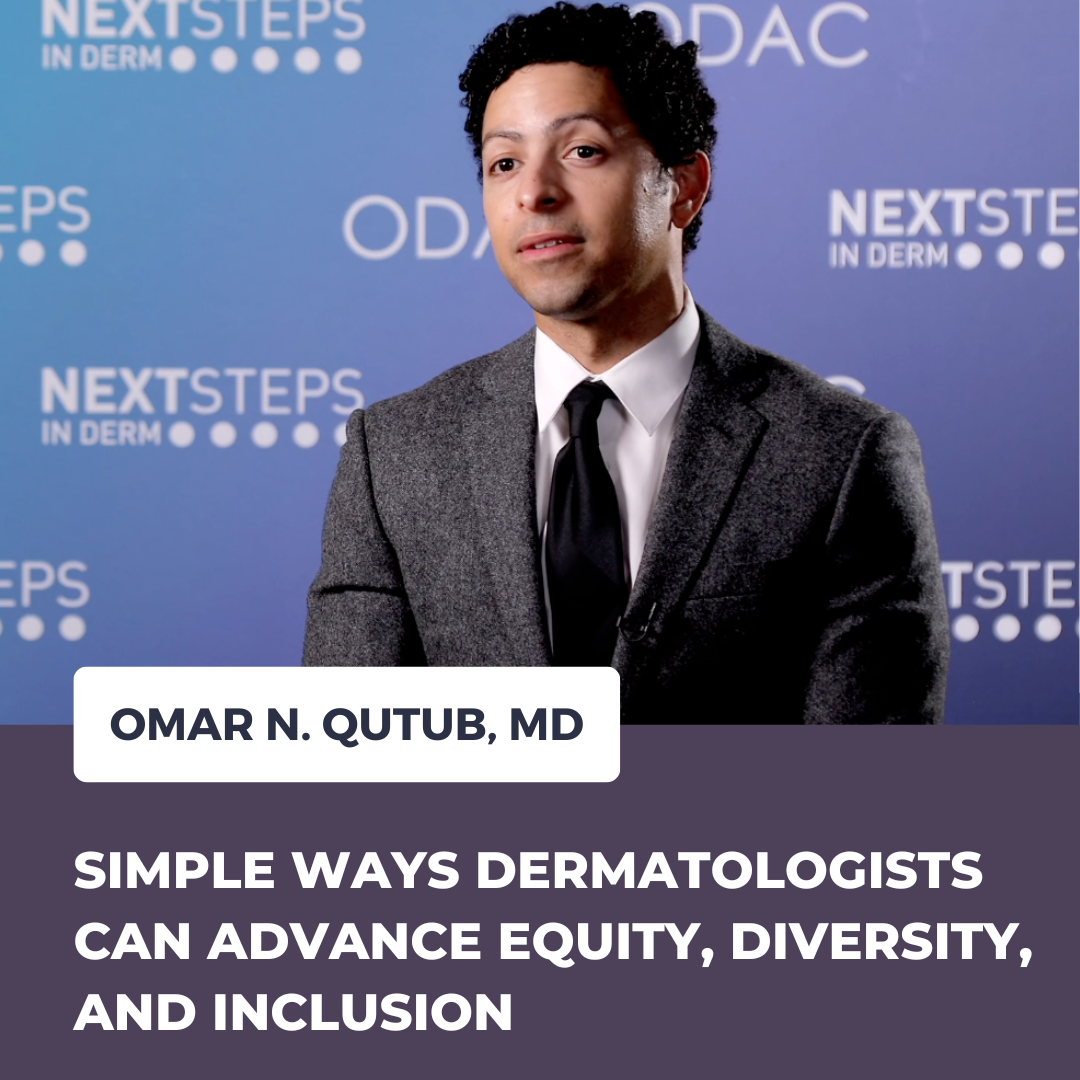Next Steps in Derm, in partnership with ODAC Dermatology, Aesthetic and Surgical Conference, interviewed Dr. Omar N. Qutub (founder of his private clinic Defining Dermatology in his native Portland) about equity, diversity, and inclusion. Watch him unveil three simple ways clinicians can take action to help transform the face of dermatology.
Further Reading
If you would like to read more about Equity, Diversity, and Inclusion, check out the following 3 articles recently published in the Journal of Drugs in Dermatology.
Assessment of Dermatologists at Skin of Color Clinics
As the US demographics change towards majority persons of color, only a small percentage of dermatologists specialize in skin of color. In the past 20 years, there has been growth in skin of color (SOC) specialty clinics. This study identifies characteristics that influence dermatologists’ decision to focus on ethnic skin, by evaluating demographics, medical training and practice characteristics of dermatologists who primarily specialize in SOC.
![]() A Genderfluid Approach to Aesthetic Language in Dermatology
A Genderfluid Approach to Aesthetic Language in Dermatology
INTRODUCTION
Dermatologists are in a unique position to help transgender and non-binary individuals achieve an appearance that corresponds to their identity. Minimally invasive procedures for gender affirmation are relatively safe and customizable, providing an increasingly favorable treatment niche for these patients. However, many physicians employ gendered language such as “masculine” or “feminine” to describe aesthetic features or traditional ideals of beauty that might not correspond to the way many transgender, nonbinary, and even cisgender patients see themselves or wish to be seen. Describing appearances as more ‘feminine’ or ‘masculine’ is a subjective generalization that can cause psychological upset or frank offense for a patient with a nonbinary gender identity or gender dysphoria. We believe that this gendered language should be avoided or minimized in most clinical interactions with patients, in the media, and in marketing. We urge dermatologists to adopt gender-neutral aesthetic language that describes the individuals’ specific goals and features rather than relying on historically gendered beauty ideals. Read the full article here.
![]() Diversity in Dermatology: Dermatology Resident Exposure to Skin of Color
Diversity in Dermatology: Dermatology Resident Exposure to Skin of Color
INTRODUCTION
Due to increasing diversity of the United States, with an estimated 50 percent of the population identifying as non-white by the year 2050, it is imperative to improve medical knowledge regarding specific conditions affecting this population as well as medical trainees’ confidence when caring for these patients. Disparities in dermatologic training regarding skin of color (SOC) pathology have been observed. Dermatologic health inequalities in ethnic minorities have also been reported. This study evaluates current trends in SOC residency curricula and assesses confidence in caring for this population, from the standpoints of both the program director (PD) and resident. An anonymous survey approved by the Institutional Review Board at the University of Florida was distributed to dermatology postgraduate year (PGY) 2–4 residents and program directors (PDs) through the Association of Professors of Dermatology e-mail listserv. The number of questions varied based on respondent answers. The survey evaluated SOC pathology exposure via lectures, on-site clinics, electives, or instruction by SOC experts. Additional questions were asked regarding resident confidence level in treating affected patients of color. PDs also received questions regarding their assessment of resident confidence levels. Read the full article here.
![]() Evaluation of a Skin of Color Curriculum for Dermatology Residents
Evaluation of a Skin of Color Curriculum for Dermatology Residents
The United States skin of color population is increasing. Consequently, the importance of skin of color education in dermatology residency programs will continue to grow. Previous data has shown a lack of formal education on skin of color across residency programs. In order to address this identified knowledge gap, we created a curriculum focusing exclusively on skin of color for dermatology residents. The purpose of this pilot study was to examine the effect of a week-long curriculum on the perception of dermatology residents’ comfort level treating patients of color and to determine if this type of curriculum could be expanded to other dermatology residents. Results demonstrated a significant increase when residents were asked to rate their overall confidence in managing patients with skin of color on a scale from 1 (minimally confident) to 10 (extremely confident) pre- and post-intervention. Overall, 100% of learners felt that their ability to care for patients of color was improved by this curriculum and that a skin of color curriculum should be an annual component of their dermatology academic curriculum. Read the full article here.
About Dr. Omar N. Qutub
 Dr. Omar Qutub is a board-certified dermatologist hailing from Portland, Oregon. He attended the University of Oregon and later moved to complete his medical education in Washington, DC at Howard University College of Medicine followed by a medical internship at the Johns Hopkins University- Sinai Hospital program in Baltimore. Completion of his dermatology residency was at the Howard University Hospital/Veteran’s Affairs Medical Center in Washington, DC program. He currently practices medical, surgical, as well as cosmetic dermatology at his private clinic: Defining Dermatology. Dr. Qutub strives to deliver quality care for all patients that are looking for a more individualized approach to their dermatologic care and skin needs and has particular interest in hair and skin rejuvenation as well as in improving access to as well as diversifying the field of dermatology to better serve our communities.
Dr. Omar Qutub is a board-certified dermatologist hailing from Portland, Oregon. He attended the University of Oregon and later moved to complete his medical education in Washington, DC at Howard University College of Medicine followed by a medical internship at the Johns Hopkins University- Sinai Hospital program in Baltimore. Completion of his dermatology residency was at the Howard University Hospital/Veteran’s Affairs Medical Center in Washington, DC program. He currently practices medical, surgical, as well as cosmetic dermatology at his private clinic: Defining Dermatology. Dr. Qutub strives to deliver quality care for all patients that are looking for a more individualized approach to their dermatologic care and skin needs and has particular interest in hair and skin rejuvenation as well as in improving access to as well as diversifying the field of dermatology to better serve our communities.
Did you enjoy these video pearls? Find more here.

